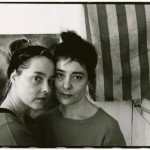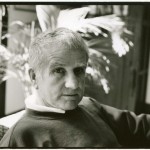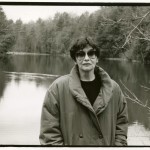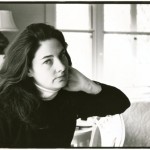A Guest of YADDO
a memory
by Louis Zoellar Bickett
When I arrived by car at YADDO, the artist/writer’s retreat in Saratoga Springs, NY, the 400-acre estate that borders the picturesque and famous Saratoga Racetrack, over a foot of snow had fallen. The estate, which makes up the famed colony, had a quiet that would occasionally be interrupted by the wind making its way through giant, ancient trees that peppered the property.
The writer Joe Caldwell, at the time of my stay, an extended resident at YADDO, renowned for his charming and beautiful novel The Uncle From Rome, was giving me a tour of the mansion and telling ‘the YADDO’ story in an animated way that spoke of his conviction and understanding of the subject. He carefully told the story of how YADDO came about. He impressed upon me, with his knowledge of the history of YADDO and the interesting, rapid-fire stories he offered, the importance of what a residency at YADDO was, and how my being a guest there could even change my life and art making—which is exactly what my winter stay there did achieve.
Joe Caldwell emphasized the importance of ‘quiet time’, which was right after breakfast and extended to late afternoon. No loud music. No conversation or visits that would disturb the other guests would be allowed. But, in the evenings, YADDO would turn out to be, in spite of the serious reputation of the place, a very social place.
The first five days gave me the impression that my snow-covered retreat would be an isolated, and even lonely experience. That proved not to be the case, for, within a few days, it was as if winter had never existed—the snow was melted away by the arrival of an early spring with buttercups shooting up overnight revealing masses of yellow around the spacious grounds. Studio visits
Became the norm. Cocktails and wine before and after the evening communal meal were consumed with great regularity. A cocktail party hosted by the president of YADDO, Michael Sundell and his wife Nina Castelli Sundell was held in their cottage at YADDO in a beautiful room where a wall installation of
Berndt and Hilla Becher photographs dominated the space, and, set the tone for ‘art conversation’ during the party—conversations I can fully recall to this day. The Sundells were the perfect hosts.
A Brief History of YADDO
YADDO was a summer retreat for Spencer and Katrina Trask and their four children. Spencer Trask was a successful financier with an estate valued at 15 million dollars (roughly 1.5 billion in todays money). Spencer and Katrina’s four children all died in youth, leaving no one among family and friends, as Joe Caldwell related to me that crisp morning, in need of their inheritance—“all their relatives were as rich as they or richer”, Caldwell told me. Spencer and Katrina established a trust in 1900 that left and endowed the estate for the use of artists, writers and composers. The baronial mansion, which stands today, was the center of YADDO activity. I remember the beautiful L.C. Tiffany mosaic, appearing as if it had been produced the day before.
The first director of YADDO, Elizabeth Ames, held the position from 1925 when the first ‘Guests’ at YADDO arrived to 1969 when she retired. Her influence was significant in forming YADDO as a retreat that produced great, historic and lasting work—Truman Capote wrote his first novel there (Granville Hicks AND Malcolm Cowley were on the admission committee that invited him), and, Eudora Welty wrote her first collection of stories there. Joe Caldwell fired off his ‘Elizabeth Ames’ stories in Gatling gun fashion.
Before her ‘invitation to a guest’ policy gave way to the committee system that holds forth to this day, Ames’ invitation was the prevailing policy. She would ask a writer or artist to be a ‘guest’ at YADDO. And, as Caldwell explained, “one is a guest of YADDO. Not a resident.” The nearly ninety years of YADDO’s existence is a storied past. The roster of guests is amazing. I remember thinking at the time: “How did this happen to me—do I deserve this? I must be dreaming”.
The Guests of YADDO
Joe Caldwell recited the names: James Baldwin (I read seven of his books that were in the YADDO library while I was a guest), Elizabeth Hardwick, Robert Lowell, Carson McCullers, Louis Zukofsky, Katherine Anne Porter, William Carlos Williams, Denise Levertov, Aaron Copland, Delmore Schwartz, Leonard Berstein, Milton Avery, Sylvia Plath, Philip Guston, John Cheever (he came so often a swimming pool was built for his exercise), Henri Cartier-Bresson, and Clyfford Still, to offer a short list, all walked around the lush rose garden, strolled along the four placid lakes, and created their art there as guests of YADDO Corporation. The list that did not make the cut is interesting as well—recommended but not invited were Eva Hesse (“she seems to make her art out of string that is painted gray!”), Allen Ginsberg, Lawrence Ferlinghetti, and Henry Miller—access denied.
My guest stay, being the winter session, held a much smaller group than the summer session, and it was an intimate group that I came to know.
YADDO, when I was there in 1995, fed and housed me. And feed me they did. With a talented and inventive Chef on board the feeding day started with breakfast, which at the conclusion a lunch box was handed out to be taken back to the studio—I actually had two—a writers nook in my bedroom and a light filled studio down the hill from my room for sculpture production. The evening meals, often theme oriented, were attended by all the guests and the conversations were a point of inspiration. One felt like an artist there, and really, a kind of important artist, a community, as if what we were doing was important, right, and even historic. After all, at that place we were steeped in a history that was infectious. That first night, sitting at the long oak table, other than Joe Caldwell, was A.M. Homes (I had already read her coming of age novel Jack before I met her), the playwright Mac Wellman, the poet Christopher Bursk (whom we all thought was the most serious and reserved of the guests—actually he worked all the time he was there—unlike the rest of us who enjoyed the sanctity of after dinner cocktails, he, went back to his room to write), the writer and critic Linda Yablonsky (she was then working on her provocative novel The Story of Junk), the mysterious identical Kenyon Twins—photographers and installation artists who always seemed to be together, and the artist and activist Andrew Castrucci, whose studio was across the field from mine, and whose gallon of urine installed in his YADDO studio influenced my own work enormously—even after many trips to Europe I felt as if I were viewing art in Castrucci’s studio that I had never seen before. The guest that I would become an inseparable friend with while at YADDO, always sitting, at breakfast and dinner, to my right, was the writer Carole Klein (Mothers and Sons, Aline, and Gramercy Park). After that first dinner, and following cocktails in a room that could have been a Hollywood set, we met for a twice a day walk, morning and evening, for the length of my complete stay. The walks were like therapy sessions. Klein, with master’s degrees in both sociology and psychology, was the type of woman that drew me in. A master storyteller, she eventually completed a double stay at YADDO while writing the first of her two biographies of Doris Lessing. I learned more about Lessing and The Golden Notebook than one would think possible, and Carole Klein learned more about me than she likely needed or wanted to know. After several weeks of walks she concluded that no I did not have a sexual identity complex—I can still hear her strong NYC, educated accent tinged with a flow of Jewish humor like from a Woody Allen film—“no Louis, you are gay for sure—you are simply suffering from ‘separation anxiety’—read my book Mothers and Sons—you will get it”.
Eighteen years later, back in Lexington, KY, still making art, but due to a guest stay at YADDO, art much different from what I was producing before, I realize what YADDO was really about. It was about feeling and seeing. And, it was about changing because of that. Not only was it about taking a particular road, but also. it was about a journey rather than just a destination. And when analysis is done, art making is like that ancient inscription at Thermopylae, “traveler, when you get to Sparta, tell them we are still here.” When one is a guest of YADDO, one is always, still there.
Louis Zoellar Bickett
Lexington, KY
I could not think of writing this memory without thanking Jim Gray, a businessman and art collector at the time of my YADDO stay, now the Mayor of Lexington. His financial support of my studio not only made the YADDO stay a reality—it kept me in Lexington.
The research for this memory came from my notes and journals and from Yaddo, Making American Culture, edited by Micki McGee.
Louis Zoellar Bickett is a writer, critic, Archivist, and artist living in Lexington, KY. He is a three time Al Smith Fellowship recipient and a YADDO Fellow.









